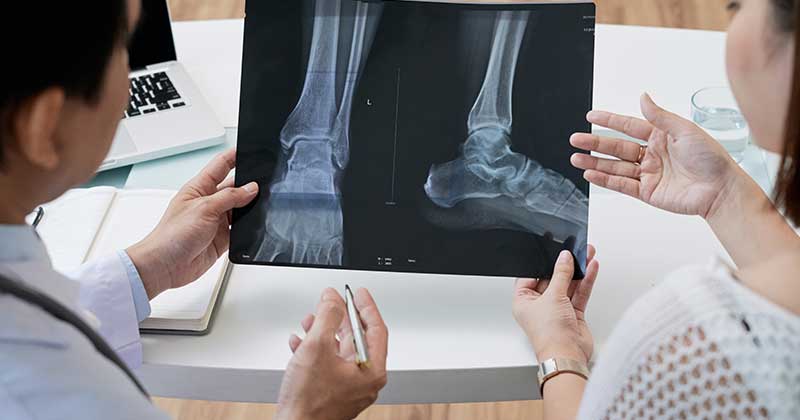Finding a Podiatry EHR That Gets Out of the Way

From advances in wound care to smart wearables in diabetic foot management, the face of podiatry is shifting and evolving. A practice’s electronic health record (EHR) should be doing the same.
The right podiatry-specific EHR should streamline your workflows, not slow them down. If your current system feels clunky or generic, it may be time to explore options designed specifically for podiatry practices.
Whether you’re a foot and ankle specialist or looking for an EHR for a small podiatry clinic, this article will help you understand:
- What makes a podiatry EHR unique
- The benefits of choosing the right one
- How to select the best system for your practice and patients
What Makes a Podiatry EHR Different?
Unlike general platforms, a podiatry EHR is designed to meet the specialized needs of podiatrists. Your practice focuses on the lower extremities, such as foot and ankle injuries and diseases, and the conditions you deal with require tailored solutions.
For example, a podiatry EHR can support you in diagnosing, treating, and preventing foot and lower limb disorders through specialty templates, imaging integrations, and evidence-based care pathways.
A generic EHR system might offer a “catch-all” solution, but it often lacks the customization needed for podiatry-specific workflows. Some of the factors that make a podiatry EHR unique include:
- Specialized Templates: The system offers templates specific to foot health conditions, surgeries, wound care, and diabetic foot management.
- Integrated Imaging Tools: These features allow podiatrists to manage X-rays, ultrasounds, and custom orthotics data easily.
- Laser-focused Documentation: The platform offers quick access to tools for noting observations about biomechanics, gait, and footwear assessments.

Benefits of Using the Right Podiatry EHR
Installing the right podiatry-focused EHR software can change the way your practice runs. Here’s how it can benefit both you and your patients:
Streamlined podiatry workflows
Charting inefficiencies and repetitive documentation can slow down your workflows. However, the right EHR allows you to spend less time dealing with these issues thanks to templates and features built just for podiatry. Everything from charting to prescriptions can be done with greater speed and fewer clicks.
Deeper focus on patient care
Efficient workflows also equal more time with your patients. The right EHR system in place supports more rapid diagnostics, thorough care plans, and clearer communications with patients and referring doctors.
Integrated billing services in podiatry EHR
Easily manage billing and coding with tools specifically designed for podiatry. For example, automating billing processes minimizes errors and ensures faster reimbursements. Automated coding algorithms, for instance, can analyze clinical documentation to generate common medical codes such as musculoskeletal conditions (M21.40), further improving accuracy and reducing errors.
Modern accessibility
Cloud-based systems allow you to access patient records on the go. Mobility is critical whether you’re working on a tablet in the treatment room or from your smartphone while talking to patients remotely.
HIPAA-compliance and security
A secure EHR for podiatry does two things. It helps you follow regulations while securing sensitive patient information. For example, a HIPAA-compliant patient portal offers specific features like encryption and access controls.
These measures allow you to communicate with patients securely by text or email while remaining compliant with HIPAA rules.
RELATED ARTICLE: How the Right EHR Can Save Your Practice Money.

Key Features to Look for in a Podiatry EHR That Works for You
Stepping into the future of podiatric care requires the right tools. When evaluating a podiatry EHR solution, there are a few core features to prioritize:
An All-in-One System with Podiatry-Specific Templates
Though podiatrists may see many of the same conditions, they will not always share the same documentation workflows. For example, your podiatry clinic may not need the same features as a large practice with multiple locations. Using platforms like DrChrono EHR for Podiatry can help meet these unique demands.
This system is an EHR, practice management, and medical billing platform in one solution, streamlining patient care, charting, appointments, and billing tasks seamlessly. With a customizable dashboard, this simplified platform is tailored to your needs, keeping your podiatry practice agile and intuitive, supporting your commitment to foot health. As a fully integrated platform, small to medium-sized practices will also appreciate its streamlined features and personalized tools.
For instance, DrChrono EHR has podiatry-specific templates for chronic and acute foot/ankle conditions, such as plantar fasciitis, diabetic foot, bunions, heel pain, and more. It also offers customizable templates, making clinical notetaking more efficient and aligned with your needs.
Seamless Integration with Diagnostic Tools
From routine podiatric assessments to intricate surgical interventions, you must choose an EHR that easily integrates with diagnostic tools or custom orthotics. For example, podiatry EHR software should allow seamless access to imaging, such as X-rays and ultrasounds, with patient records for immediate reference and analysis. Also, check to see if the EHR can order X-rays, bone scans, and MRIs directly on the web or iPad and receive results in the EHR.
Patient Scheduling Functionality
Look for robust podiatry EHR scheduling tools that help easily manage appointments while reducing no-shows. For example, the DrChrono EHR for Podiatry offers several scheduling features, including:
- Allowing patients to schedule appointments, upload their insurance information for instant eligibility verification, and check in online using iPhone, iPad, or the web.
- A self-check-in Kiosk on iPad that lets patients easily verify background information, answer basic questions, submit proof of insurance, and sign consent forms.
- Sending automated reminders to new and re-occurring patients using emails, text, and/or phone calls.
Efficient Podiatry Documentation and Charting Tools
Ensure the EHR software includes drag-and-drop features that make documentation faster, without compromising accuracy. Podiatrists will also find that a free draw feature can benefit their clinical workflows.
For example, the DrChrono Free Draw tool allows you to upload or take photos of affected areas and annotate directly onto them in real-time, fostering a deeper understanding of the issue through visualizations.
Typing out notes is time-consuming and inefficient. A valuable tool that streamlines this process is medical speech-to-text. Choose a podiatry EHR system with intelligent dictation software that recognizes medical speech and learns your accent as you speak, automating notetaking.
Integrated Billing and Coding
As a podiatrist, you may face fragmented systems for billing and practice management. An integrated EHR addresses this issue and streamlines front-office tasks, such as eligibility verification, intake forms, and billing. A built-in billing tool created for podiatrists also ensures accurate coding and faster payouts from insurers.
Look for podiatry EHR software that improves your reimbursements, provides a clearinghouse, and has a quick turnaround rate for rejected and denied claims. And see if the billing software offers a real-time insurance eligibility feature that lets your practice quickly check patients’ eligibility on iPad, iPhone, or the web.
Also, verify that the EHR can provide all current medical billing codes and ensure your practice receives billing assistance for durable medical equipment (DME), prosthetics, orthotics, and supplies.
Data-Driven Practice Management Tools
Dashboard and reporting tools in EHRs are essential for podiatrists because they provide the data and insights needed to enhance patient care, manage practice operations efficiently, and ensure regulatory compliance.
For example, real-time analytics and dashboards can identify missed charges, inefficiencies, and bottlenecks in both clinical and administrative workflows. This insight allows practice managers to make data-driven decisions to boost productivity and strengthen cash flow.
By providing built-in tools to track compliance, EHR reporting also helps your practice avoid costly penalties and legal issues that can arise from billing errors or regulatory non-compliance.
Cloud Based and Mobile Friendly
A cloud-based EHR for podiatrists allows you to access your records anytime, anywhere. Seek a vendor that provides mobile-friendly podiatry EHR software and web applications. This solution delivers the flexibility needed to access your EHR from anywhere via your phone, tablet, or computer.

How to Evaluate and Choose the Best Podiatry EHR for Your Practice
With so many options claiming to be the “best” EHR software for podiatrists, how do you find what truly fits your needs? Follow these five steps to make an informed decision:
Step 1: Assess Your Practice’s Greatest Need
Don’t rely on the vendor to discuss features that they think are important. Instead, evaluate your practice and identify your most pressing challenges. Do you struggle with things like:
- Slow documentation processes
- Limited tools for patient engagement and care follow-up
- Patient payment collection efforts
- Triage and scheduling
- Fragmented systems for billing and clinical tools
Understanding your specific issues and bottlenecks will help you prioritize features.
Step 2: Look for Demos and Free Trials
Most EHR providers offer demos or free trial periods. Take advantage of these opportunities to explore how intuitive and customizable the system really is. Make sure the free trials are truly “hands-on” and provide access to all system functions like clinical notetaking, scheduling, and billing features (not just limited features).
Step 3: Consult with Your Team
Avoid making decisions on a single perspective or issue. Get input from your colleagues, IT managers, and staff. They’ll be using the system daily, so getting their feedback is a must.
Step 4: Compare Vendors
Here are a few questions to consider when comparing potential vendors:
- Do they offer podiatry-specific templates and workflows?
- Does the EHR track and monitor productivity?
- Is the platform cloud based and mobile friendly?
- How does the office portal differ from the mobile portal?
- How does the system increase compliance?
Step 5: Focus on Long-Term ROI and CBA
While cost is an important factor, don’t decide solely based on price. Consider the return on investment (ROI) and cost-benefit analysis (CBA) regarding efficiency, patient care, and reduced billing errors.
ROI calculates the most direct financial benefits expected from the EHR versus the costs of implementing the EHR alone.
Example: Increased revenue in Q4 due to more accurate medical coding and billing and better patient collection rates.
CBA is more holistic than ROI and looks at both direct and indirect costs and benefits.
Example: Improved staff and patient satisfaction. The staff notices their duties are less burdensome, leading to greater job satisfaction and retention rates.
Patients also see that the practice runs better and that wait times are decreased. They feel satisfied and more likely to remain loyal to the practice.
RELATED ARTICLE: EHR Implementation Checklist - How to Ensure a Smooth Transition
Don’t Settle—Find a Podiatry EHR That Works for You
Investing in the right podiatry EHR can revolutionize your practice by simplifying workflows, improving patient care, and streamlining billing. Focusing on features that fit your specialty ensures your EHR works for you—not against you.
If you’re ready to explore better options for your podiatry practice, assess whether your current system meets your needs, or it’s time for a change.
Want more guidance? Contact DrChrono to find an affordable podiatry EHR option that checks all the boxes for your practice!